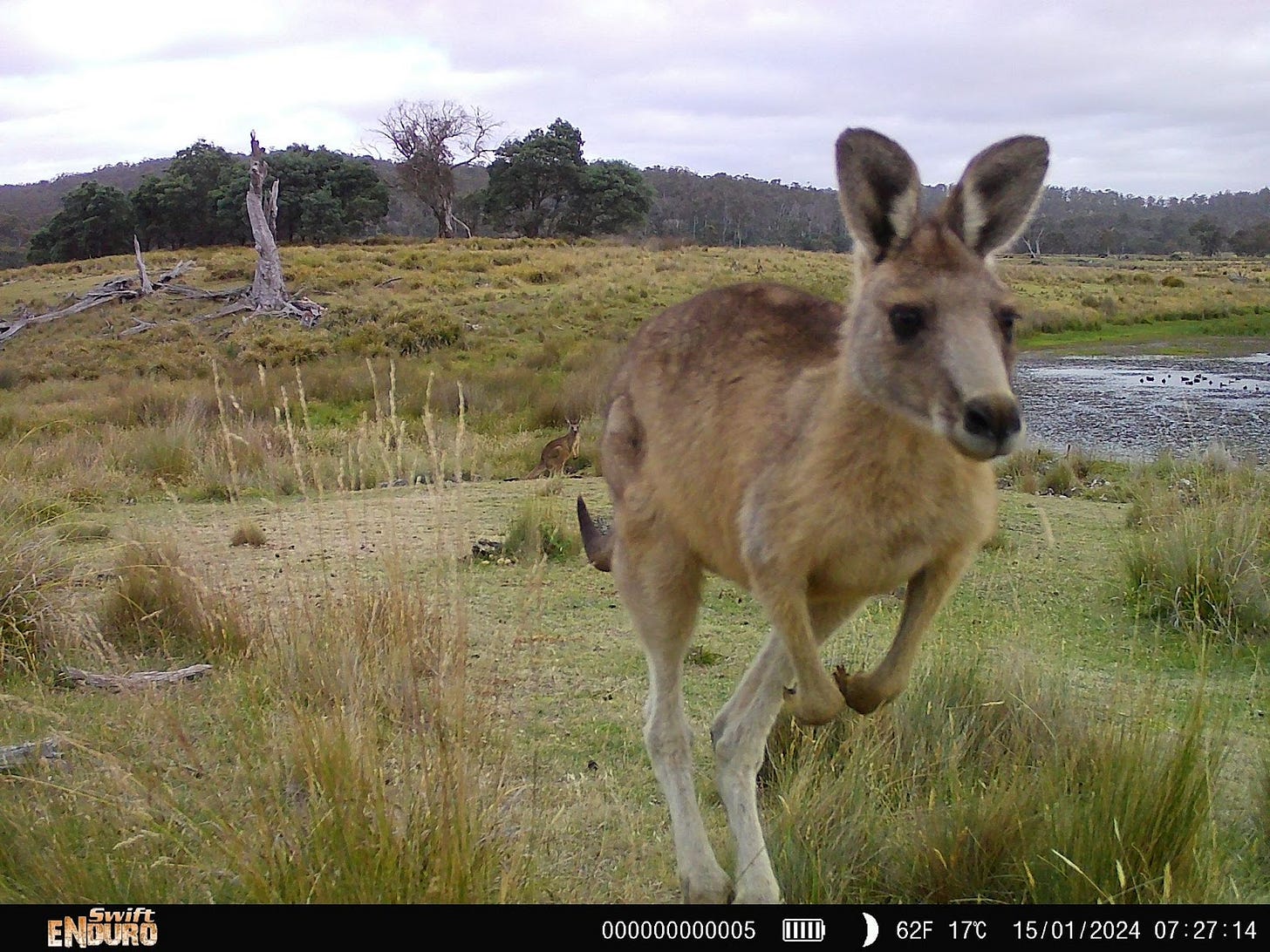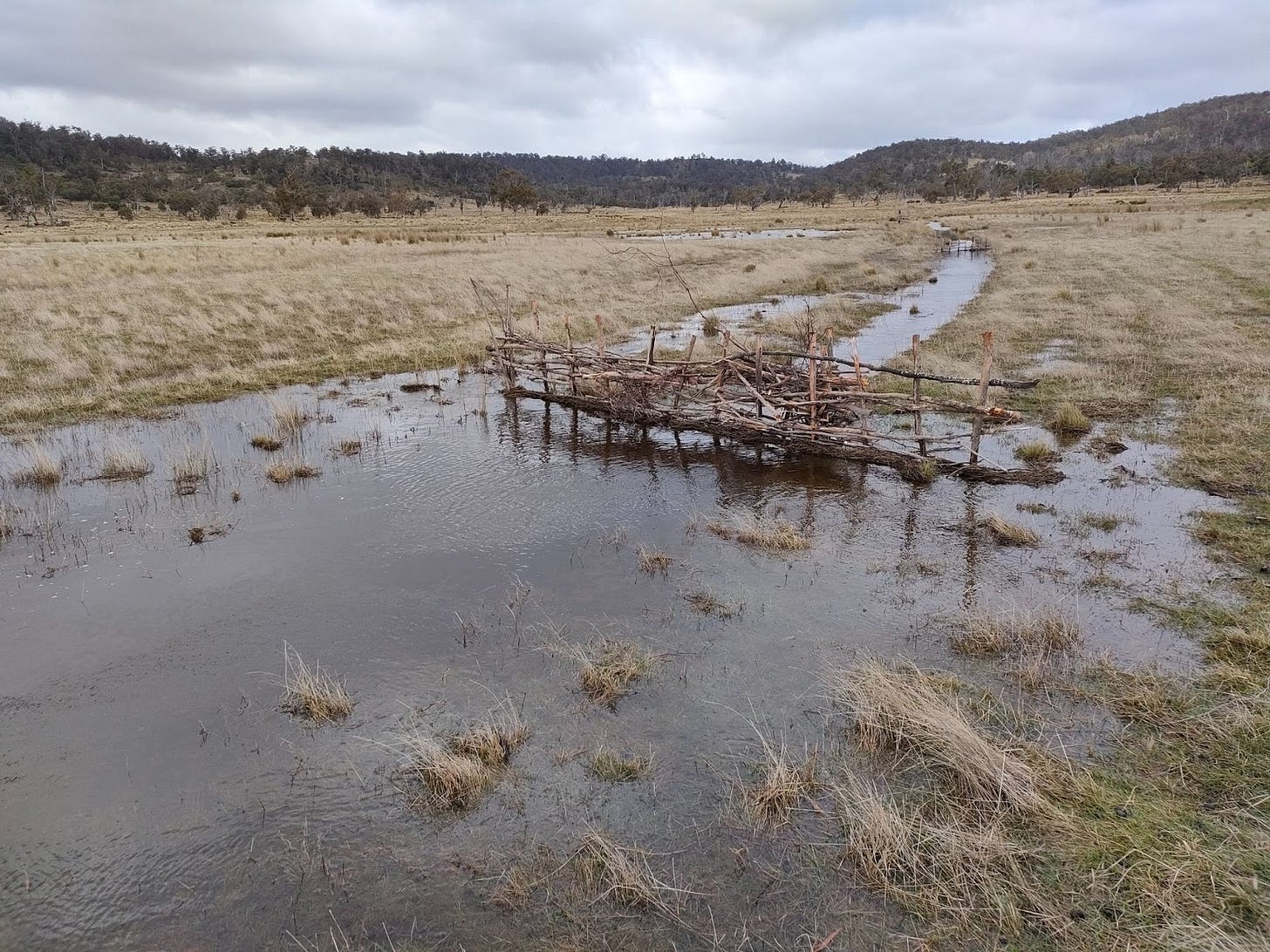How we’re using leaky weirs to support rehydration in Stocker’s Bottom
Leaky weirs are structures built inside a waterway that slow and filter water, giving it a chance to infiltrate and recharge the aquifer.
Stocker’s Bottom sits near The Quoin’s northern boundary. It’s 487 hectares, and is surrounded by sandstone hills that have eroded over time, giving the area a sandy soil profile.
When it rains, water rushes down these hills into Stocker’s Bottom, where it once spread broadly and thinly across the entire grassland. Historically, the water would have sat in the landscape, slowly absorbing into the aquifer, ensuring it was available to the grasses and trees in the harshness of summer.
But in the mid-to-late 1900s, trees were cleared from the area, and then in 1992, kilometres of drainage channels were cut into the ground. At the time, the property was used for livestock grazing, and the goal was to keep the paddock dry by quickly funnelling water to the nearby dam, where it could be used at a later date.

Today, when it rains, water races through the drainage channels in Stocker’s Bottom, picking up macropod and deer manure on its way to the dam. This causes a nitrogen flush, which promotes algal blooms.
In the future, we intend to rehabilitate Stocker’s Bottom, but given its size, we’re starting with and learning from a smaller rehabilitation project at Honeysuckle Flat. In the meantime, we’re undertaking some micro-experiments at Stocker’s Bottom which explore how we can rehydrate the landscape.

Unfortunately, we can’t simply push the soil back into these drainage channels, as it’s washed into the dam over the last three decades. We’re also reluctant to dig this material out of the dam and use it to backfill the channels, because in the time since this dam was created, it has evolved into a wetland with healthy ecological function. Our camera traps show visiting ducks, masked lapwings, cormorants, herons and white-bellied sea eagles, and it's big enough that a pair of black swans nest here too.
Instead, we’re experimenting with using leaky weirs to help rehydrate the landscape. This technique is low intervention and high impact, keeping with our approach of assessing how we can gently add to a landscape to help it thrive by reviving its ecological function, not just for macropods, but for all species.

Leaky weirs
Leaky weirs are structures built inside a waterway that slow and filter water, giving it a chance to infiltrate and recharge the aquifer. Leaky weirs are made from natural materials found in the landscape, with large logs and rocks commonly used in larger streams.
Because our drainage channels are relatively thin and shallow, we construct our leaky weirs from debris, spending about 1.5 hours collecting sticks and bushy branches from surrounding forest, and another 1.5 hours building the structures. We don’t dig holes; and sometimes we don’t even use a chainsaw. They can be made with a hand-saw, a post-driver and a technique that comes naturally to everyone who’s tried it so far.
Here’s how we do it…
Gather thin branches (more than 1 metre in length) for upright poles and a variety of local bushy plant species.
Use a post driver to install poles 60cm apart.
Weave plants in a criss-cross pattern — starting with the brushy species, to ensure they pad the base of the structure.
Repeat, repeat, repeat.
Weave a few branches at the top of the structure to act as a perch for birds.
The process is simple but, as you can see, the results are impressive.
Iterating our design
We built our first four leaky weirs in 2022 — and have built more since, tweaking the design and learning from each iteration. We’ve experimented with the shape, trialling cage-shaped weirs that could protect young trees in the future. We’ve added biochar to the base of the weirs, with the hope it will adsorb nitrogen and keep it in the landscape. And we’ve incorporated rocks into the design, creating pockets where plants and insects can thrive.
In 2025, we plan to experiment with adding more rocks into the channels, upstream of the leaky weirs, so they absorb the initial energy from the water.
The additional benefits
Leaky weirs slow the flow of water so it can spread across the landscape and sink into the soil, but they have a number of other benefits too.
They filter manure from the water, enabling it to float to the ‘high tide’ mark, where it breaks down and provides fertility in those locations.
They provide perches for birds, which then, in turn, bring seeds back to the landscape.
They create habitat and shelter for insects and small mammals and pockets where seeds can grow.
They are easy and rewarding to construct, giving people a chance to interact with the environment in a way that boosts their wellbeing and the health of the ecosystem too.
They enable us to learn quickly. Trees take 5-10 years to grow enough to really represent a strong opportunity for diversity, but we can immediately see what birds are nesting on our leaky weirs, what animals come to investigate, and what plants take root in the crevices.
And they create opportunities within the landscape. When water is racing down a perfectly cut channel, it's a very simple energy system. But natural systems aren’t linear and simple. Natural systems are chaotic — and chaos is opportunity. Leaky weirs bring some of this chaos back to the landscape, enabling species to return to and interact with the area in unexpected ways.
This article was written by: Bronte McHenry
And edited by: Andrew Wenzel, Karina West, Michael Honey and Lisa Miller
The Quoin is Wedgetail’s living laboratory, where we develop and deploy technologies, products and practices to accelerate regeneration at scale.
If you’d like to collaborate, please get in touch.









